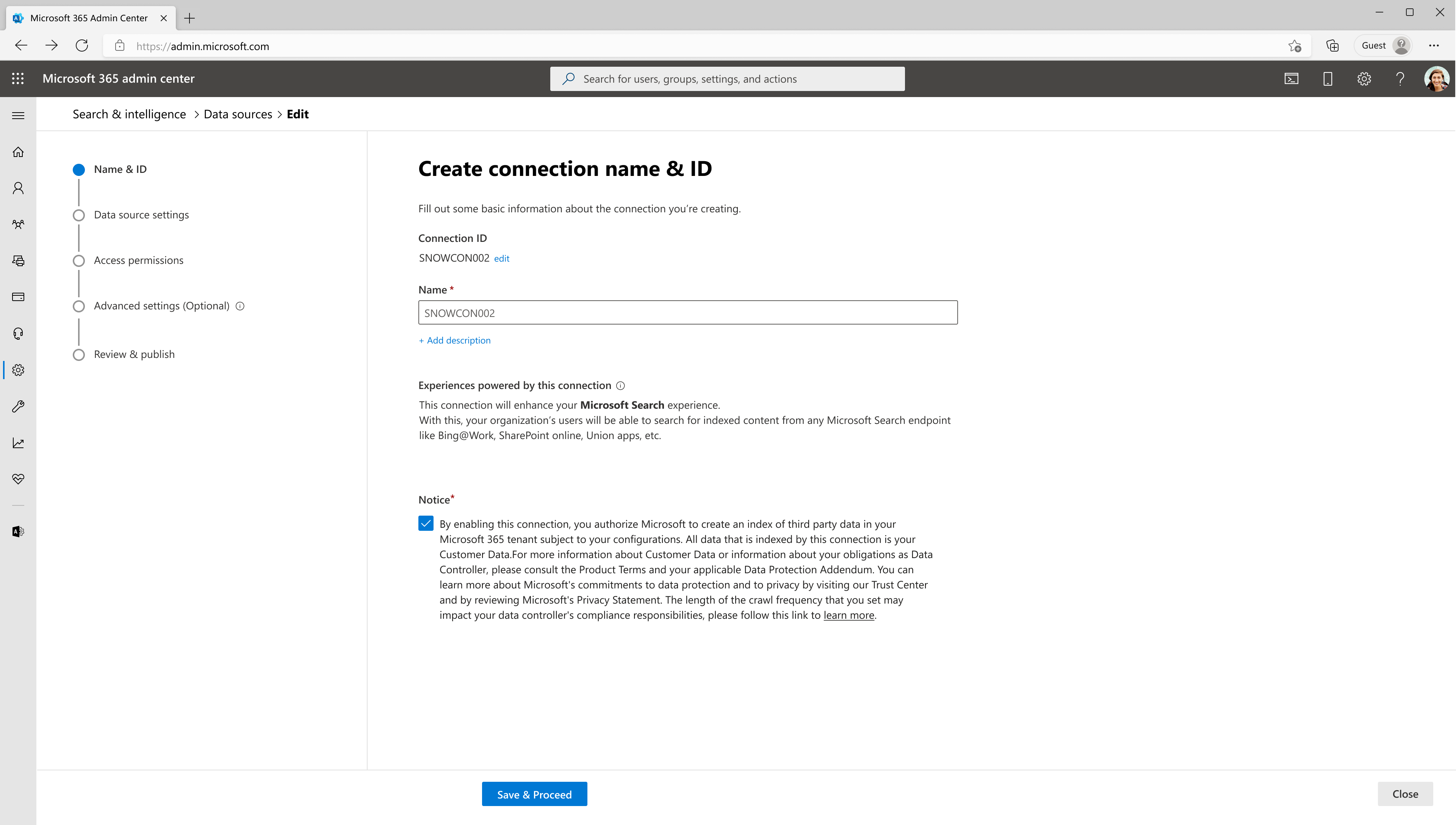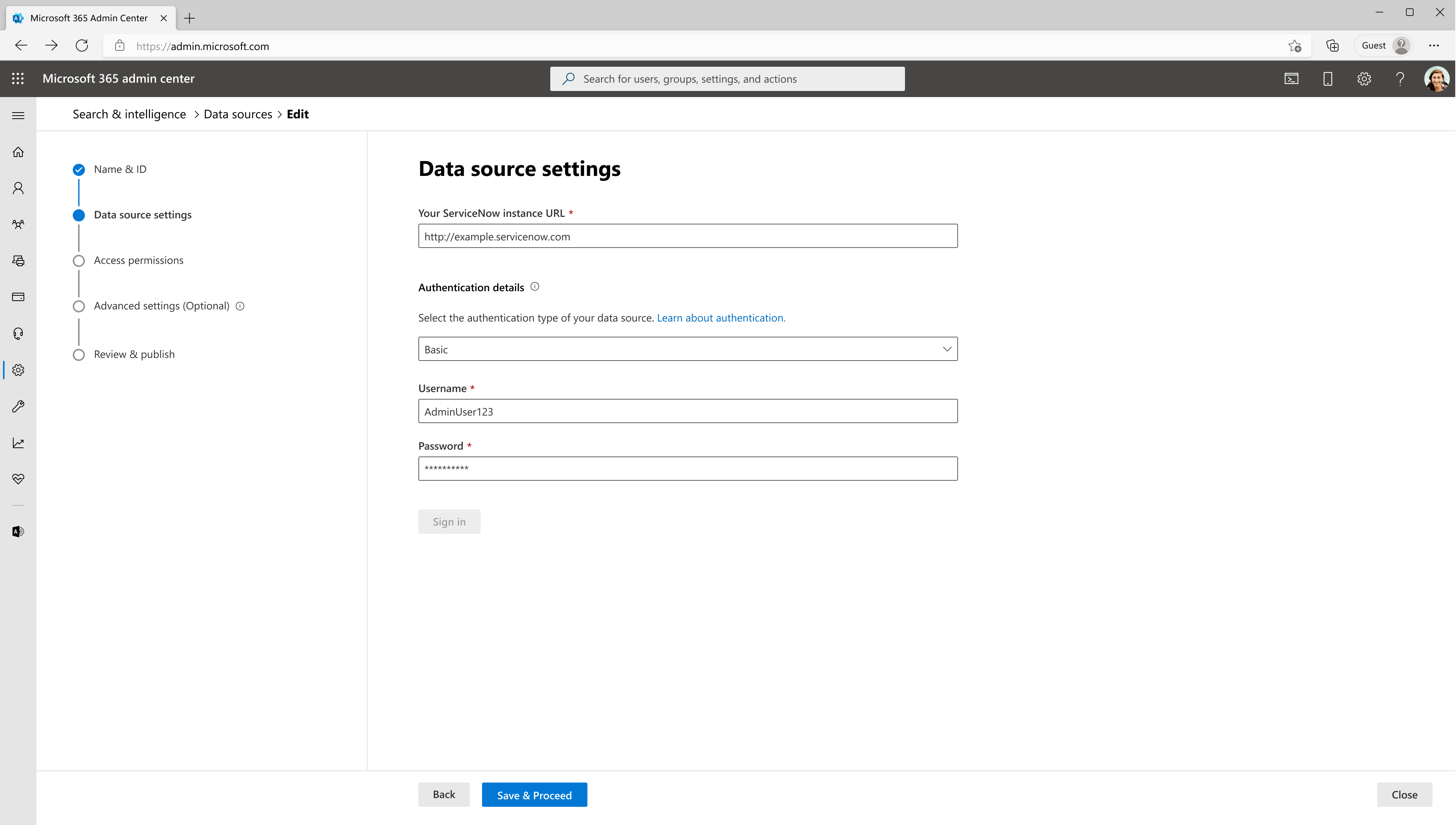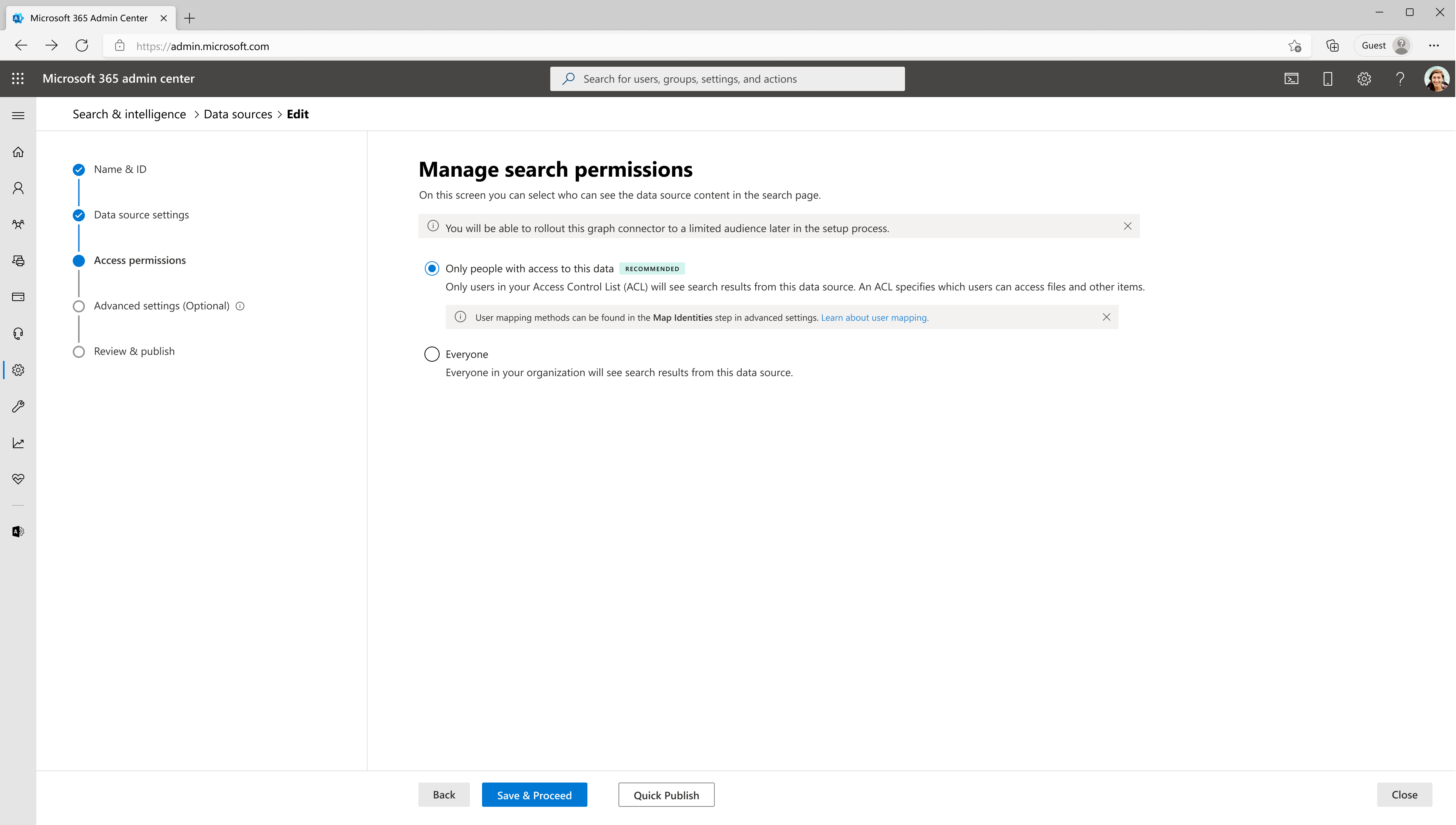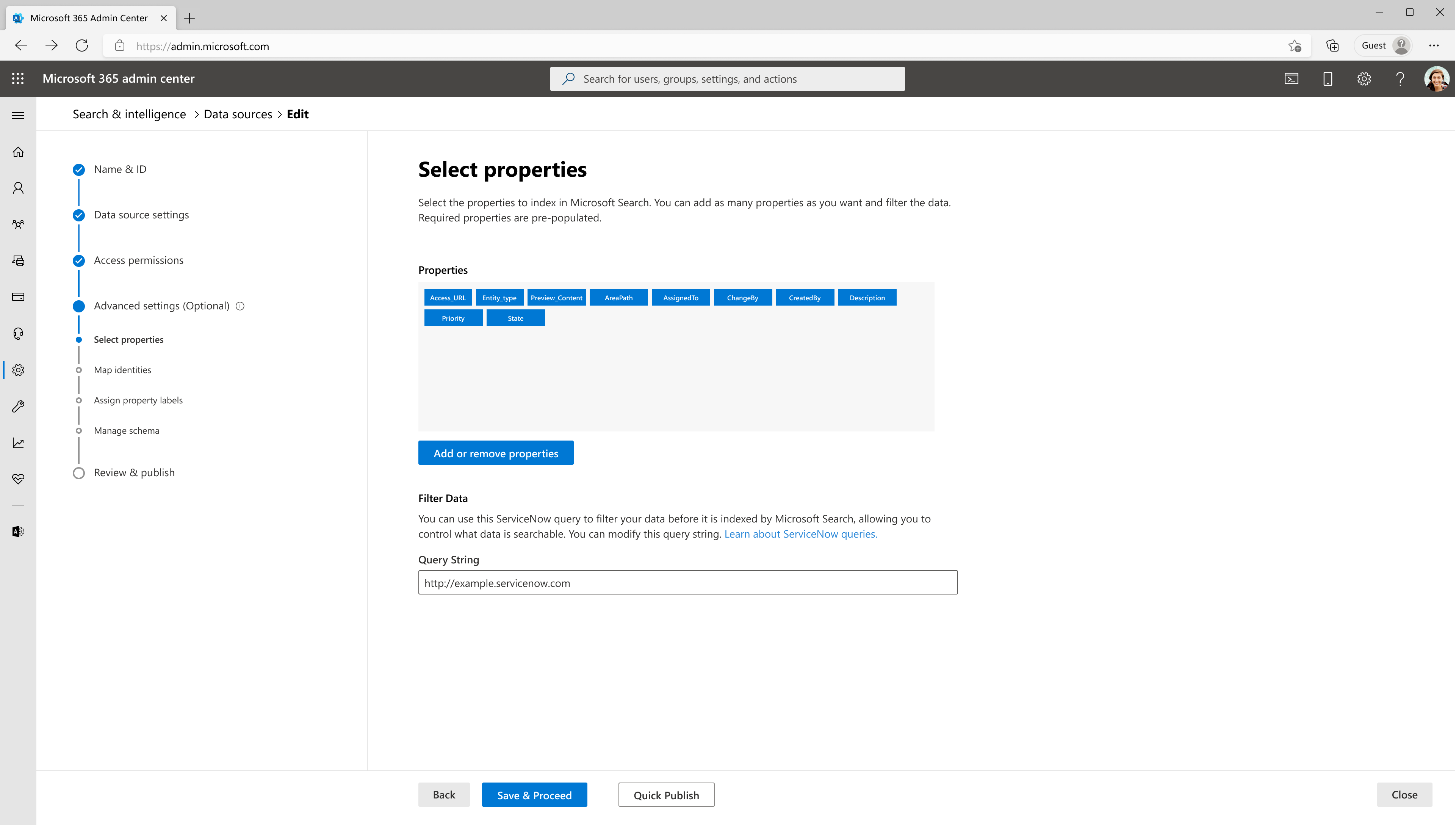ServiceNow Knowledge Microsoft Graph connector
With the Microsoft Graph connector for ServiceNow, your organization can index knowledge-base articles that are visible to all users or restricted with user criteria permissions within your organization. After you configure the connector and index content from ServiceNow, end users can search for those articles in Microsoft Copilot and from any Microsoft Search client.
You can also refer this video to learn more about Graph Connector's capability in managing search permissions.
This article is for Microsoft 365 administrators or anyone who configures, runs, and monitors a ServiceNow Knowledge Graph connector. It supplements the general instructions provided in the Set up Microsoft Graph connectors in the Microsoft 365 admin center article. If you haven't already done so, read the entire Setup your Graph Connector article to understand the general setup process.
Each step in the setup process is listed below along with either a note that indicates you should follow the general setup instructions OR other instructions that apply to only ServiceNow connector including information about Troubleshooting and Limitations.
Mandatory and Optional Settings
To get you quickly started with Microsoft Graph connectors, the steps in the setup process are split into two groups:
Mandatory settings - You must provide some input for these steps to make the connection. The inputs (connection name, data source settings etc.) vary based on your organization's context and use-case.
Advanced settings (Optional) - As the name suggests, Advanced settings are optional steps. For your convenience, these settings in the setup process are preconfigured with default values based on the most common selections made by admins. You can choose to accept the default values or modify them to suit your organization's needs.
Get Started
Add ServiceNow Knowledge Connector
(For more details, see general setup instructions)
Mandatory Settings
1. Name & ID:
Connection Id: Edit the Connection ID if necessary(prefilled with a default and unique string). You can't edit it after you click on the 'Save and Proceed' button.
Name: Enter a name for your connection (prefilled with a default name). You can always edit it later (even after the connection is published).
2. Data Source Settings:
ServiceNow instance URL: To connect to your ServiceNow data, you need your organization's ServiceNow instance URL. Your organization's ServiceNow instance URL typically looks like https://<your-organization-domain>.service-now.com.
Along with this URL, you need a service account for setting up the connection to ServiceNow and for allowing Microsoft Search to periodically update the knowledge articles based on the refresh schedule. The service account needs read access to the following ServiceNow table records to successfully crawl various entities.
| Feature | Read access required tables | Description |
|---|---|---|
| Index knowledge articles available to Everyone | kb_knowledge | For crawling knowledge articles |
| Index and support user criteria permissions | kb_uc_can_read_mtom | Who can read this knowledge base |
| kb_uc_can_contribute_mtom | Who can contribute to this knowledge base | |
| kb_uc_cannot_read_mtom | Who cannot read this knowledge base | |
| kb_uc_cannot_contribute_mtom | Who cannot contribute to this knowledge base | |
| sys_user | Read user table | |
| sys_user_has_role | Read role information of users | |
| sys_user_grmember | Read group membership of users | |
| user_criteria | Read user criteria permissions | |
| kb_knowledge_base | Read knowledge base information | |
| sys_user_group | Read user group segments | |
| sys_user_role | Read user roles | |
| cmn_location | Read location information | |
| cmn_department | Read department information | |
| core_company | Read company attributes | |
| Index extended table properties (optional) | sys_db_object | Read extended table details |
| sys_dictionary | Read extended table properties |
You can create and assign a role for the service account you use to connect with Microsoft Search. Learn how to assign role for ServiceNow accounts. Read access to the tables can be assigned on the created role. To learn about setting read access to table records, see Securing Table Records.
If you want to index properties from extended tables of kb_knowledge, provide read access to sys_dictionary and sys_db_object. This is an optional feature. You can index kb_knowledge table properties without access to the two additional tables.
Note
Microsoft Graph Connector for ServiceNow can index knowledge articles and user criteria permissions without advanced scripts. To learn more about how the connector treats knowledge articles and user criteria permissions, see the section on Read and Deny Access to Knowledge Articles in Microsoft Graph Connector for ServiceNow.
Authentication details: To authenticate and sync content from ServiceNow, choose one of three supported methods:
Microsoft Entra ID OpenID Connect
1. Basic authentication
Enter the username and password of ServiceNow account with knowledge role to authenticate to your instance.
2. ServiceNow OAuth
To use the ServiceNow OAuth for authentication, follow the steps below.
A ServiceNow admin will need to provision an endpoint in your ServiceNow instance, so that the Microsoft Search app can access it. To learn more, see Create an endpoint for clients to access the instance in the ServiceNow documentation.
The following table provides guidance on how to fill out the endpoint creation form:
Field Description Recommended Value Name Unique value that identifies the application that you require OAuth access for. Microsoft Search Client ID A read-only, auto generated unique ID for the application. The instance uses the client ID when it requests an access token. NA Client secret With this shared secret string, the ServiceNow instance and Microsoft Search authorize communications with each other. Follow security best-practices by treating the secret as a password. Redirect URL A required callback URL that the authorization server redirects to. For M365 Enterprise: https://gcs.office.com/v1.0/admin/oauth/callback, For M365 Government: https://gcsgcc.office.com/v1.0/admin/oauth/callback Logo URL A URL that contains the image for the application logo. NA Active Select the check box to make the application registry active. Set to active Refresh token lifespan The number of seconds that a refresh token is valid. By default, refresh tokens expire in 100 days (8,640,000 seconds). 31,536,000 (one year) Access token lifespan The number of seconds that an access token is valid. 43,200 (12 hours) Enter the client id and client secret to connect to your instance. After connecting, use a ServiceNow account credential to authenticate permission to crawl. The account should at least have knowledge role. Refer to the table in the beginning of Step 2: Data Source Settings for providing read access to more ServiceNow table records and index user criteria permissions.
3. Microsoft Entra ID OpenID Connect
To use Microsoft Entra ID OpenID Connect for authentication, follow the steps below.
Register a new application in Microsoft Entra ID
To learn about registering a new application in Microsoft Entra ID, see Register an application. Select single tenant organizational directory. Redirect URI isn't needed. After registration, note down the Application (client) ID and Directory (tenant) ID.
Create a client secret
To learn about creating a client secret, see Creating a client secret. Take a note of client secret.
Retrieve Service Principal Object Identifier
Follow the steps to retrieve Service Principal Object Identifier
Run PowerShell.
Install Azure PowerShell using the following command.
Install-Module -Name Az -AllowClobber -Scope CurrentUserConnect to Azure.
Connect-AzAccountGet Service Principal Object Identifier.
Get-AzADServicePrincipal -ApplicationId "Application-ID"Replace "Application-ID" with Application (client) ID (without quotes) of the application you registered in step 1. Note the value of ID object from PowerShell output. It's the Service Principal ID.
Now you have all the information required from Azure portal. A quick summary of the information is given in the table below.
Property Description Directory ID (Tenant ID) Unique ID of the Microsoft Entra tenant, from step 3.a. Application ID (Client ID) Unique ID of the application registered in step 3.a. Client Secret The secret key of the application (from step 3.b). Treat it like a password. Service Principal ID An identity for the application running as a service. (from step 3.c) Register ServiceNow Application
The ServiceNow instance needs the following configuration:
Register a new OAuth OIDC entity. To learn, see Create an OAuth OIDC provider.
The following table provides guidance on how to fill out OIDC provider registration form
Field Description Recommended Value Name A unique name that identifies the OAuth OIDC entity. Microsoft Entra ID Client ID The client ID of the application registered in the third-party OAuth OIDC server. The instance uses the client ID when requesting an access token. Application (Client) ID from step 3.a Client Secret The client secret of the application registered in the third-party OAuth OIDC server. Client Secret from step 3.b All other values can be default.
In the OIDC provider registration form, you need to add a new OIDC provider configuration. Select the search icon against OAuth OIDC Provider Configuration field to open the records of OIDC configurations. Select New.
The following table provides guidance on how to fill out OIDC provider configuration form
Field Recommended Value OIDC Provider Microsoft Entra ID OIDC Metadata URL The URL must be in the form https://login.microsoftonline.com/<tenandId">/.well-known/openid-configuration
Replace "tenantID" with Directory (tenant) ID from step 3.a.OIDC Configuration Cache Life Span 120 Application Global User Claim sub User Field User ID Enable JTI claim verification Disabled Select Submit and Update the OAuth OIDC Entity form.
Create a ServiceNow account
Refer the instructions to create a ServiceNow account, create a user in ServiceNow.
The following table provides guidance on how to fill out the ServiceNow user account registration
Field Recommended Value User ID Service Principal ID from step 3.c Web service access only Checked All other values can be left to default.
Enable Knowledge role for the ServiceNow account
Access the ServiceNow account you created with ServiceNow Principal ID as User ID and assign the knowledge role. Instructions to assigning a role to a ServiceNow account can be found here, assign a role to a user. Refer to the table in the beginning of Step 2: Data Source Settings for providing read access to more ServiceNow table records and index user criteria permissions.
Use Application ID as Client ID (from step 3.1), and Client secret (from step 3.2) in admin center configuration wizard to authenticate to your ServiceNow instance using Microsoft Entra ID OpenID Connect.
3. Access permissions
The ServiceNow connector supports access permissions visible to Everyone or Only people with access to this data source. Indexed data appears in the search results and is visible to all users in the organization or users who have access to them via user criteria permission respectively. If a knowledge article isn't enabled with a user criteria, it appears in search results of everyone in the organization.
Important
In ServiceNow, while assessing read permissions for a user, both article-level permissions and KB-level permissions are looked at. The Microsoft Graph connector for ServiceNow treats permissions differently:
- If the article contains 'Can Read' user criteria, then they are stamped on the article during ingestion and Knowledge Base 'Can Read' / 'Can Contribute' user criteria are ignored.
- If the article contains 'Cannot Read' user criteria, and if the corresponding Knowledge base also contains 'Cannot Read' user criteria, then both the user criteria are stamped on the article.
Note: If a user is part of the 'Can Read' user criteria at the article level but not in the 'Can Read' / 'Can Contribute' user criteria at the Knowledge Base level, then the user will not have access to the article in ServiceNow but will have access to the article in Microsoft Copilot, Microsoft Search and other M365 surfaces. The workaround is to remove the user from the 'Can Read' user criteria at the article level.
If you choose Only people with access to this data source, you need to further choose whether your ServiceNow instance has Microsoft Entra ID provisioned users or Non-AAD users.
To identify which option is suitable for your organization:
- Choose the Microsoft Entra ID option if the Email ID of ServiceNow users is same as the UserPrincipalName (UPN) of users in Microsoft Entra ID.
- Choose the Non-AAD option if the email ID of ServiceNow users is different from the UserPrincipalName (UPN) of users in Microsoft Entra ID.
Note
- If you choose Microsoft Entra ID as the type of identity source, the connector maps the Email IDs of users obtained from ServiceNow directly to UPN property from Microsoft Entra ID.
- If you choose "Non-AAD" for the identity type see Map your non-Azure AD Identities for instructions on mapping the identities. You can use this option to provide the mapping regular expression from Email ID to UPN.
- Updates to users or groups governing access permissions are synced in full crawls only. Incremental crawls do not currently support processing of updates to permissions.
Advanced Settings (Optional)
1. Select properties
In this step, you can add or remove available properties from your ServiceNow data source. Microsoft 365 selects few properties by default.
The list of properties that you select here, can impact how can you filter, search and view your results in Copilot for Microsoft 365.
| Source property | Label | Description |
|---|---|---|
| AccessUrl | url |
The target URL of the item in the data source. |
| Author | authors |
Name of all the people who participated/collaborated on the item in the data source. |
| IconUrl | iconUrl |
Icon url that represents the article’s category or type. |
| Short_description | title |
The title of the item that you want shown in search and other experiences. |
| SysUpdatedBy | lastModifiedBy |
Name of the person who most recently edited the item in the data source. |
| SysUpdatedOn | lastModifiedDateTime |
Date and time the item was last modified in the data source. |
| SysCreatedBy | createdBy |
Name of the person who created the item in the data source. |
| SysCreatedOn | createdDateTime |
Date and time that the item was created in the data source. |
With a ServiceNow query string, you can specify conditions for syncing articles. It's like a Where clause in a SQL Select statement. For example, you can choose to index only articles that are published and active. To learn about creating your own query string, see Generate an encoded query string using a filter.
Use the preview results button to verify the sample values of the selected properties and query filter.
2. Map Identities
In this step, you can map identities for both Microsoft Entra ID and Non Microsoft Entra ID identity types.
- If you choose Microsoft Entra ID as the type of identity source, the connector maps the Email IDs of users obtained from ServiceNow directly to UPN property from Microsoft Entra ID.
- If you choose "Non-AAD" for the identity type see Map your non-Azure AD Identities for instructions on mapping the identities.
3. Assign property labels
Follow the general setup instructions.
4. Manage schema
Follow the general setup instructions.
5. Refresh settings
Follow the general setup instructions.
Note
Identities are only refreshed in full crawls.
Review & Publish
Follow the general setup instructions.
After publishing the connection, you need to customize the search results page. To learn about customizing search results, see Customize the search results page.
Read and Deny Access to Knowledge Articles in Microsoft Graph Connector for ServiceNow
Here is a scenario-wise depiction of how the connector treats access permissions based on user criteria in ServiceNow Knowledge:
Note
Terms used in the table below:
- No criteria: No user criteria is defined for the article or Knowledge base. (Different from empty criteria where a user criteria is defined but within the criteria all fields are empty)
- Default user criteria: User criteria defined using ServiceNow fields like Users, Groups, Roles, Location, Department etc.
- Empty Criteria: A User criteriion where all fields have empty values.
How Read access is determined
| Knowledge Base | Knowledge Article | Access | |
|---|---|---|---|
| Can read | Can contribute | Can read | |
| Any criteria | Any criteria | Default user criteria | Default user criteria followed |
| Any criteria | Any criteria | Default + Advanced criteria | Default user criteria followed. Advanced criteria ignored. |
| Any criteria | Any criteria | Empty criteria + Any criteria | Access provided to every ServiceNow user |
| Default user criteria | Default user criteria | No criteria | Default user criteria followed. [Note: If the 'Cannot Contribute' user criteria is not present, then default criteria from both 'Can read' and 'Can Contribute' are followed. But if the 'Cannot Contribute' user criteria is present, then 'Can Contribute' user criteria is not stamped.] |
| Default + Advanced criteria | Default + Advanced criteria | No criteria | Default user criteria followed. Advanced criteria ignored. |
| Empty criteria | Any criteria | No criteria | Access provided to every ServiceNow user |
How Deny access is determined
| Knowledge Base | Knowledge Article | Access |
|---|---|---|
| Cannot read | Cannot read | |
| Default user criteria | Default user criteria | Both criteria at base and article level are honored. |
| Advanced criteria | Any criteria | Deny access to everyone. |
| Any criteria | Advanced criteria | Deny access to everyone. |
| Empty criteria + Default user criteria | Any criteria | Deny access to everyone. |
| Any criteria | Empty criteria | Deny access to everyone. |
Limitations
Important
The ServiceNow Knowledge Microsoft Graph connector has the following limitations in its latest release:
- User criteria with advanced scripts aren't supported in the current version. To learn more about how the connector treats knowledge articles with advanced scripts, see the section on Read and Deny Access to Knowledge Articles in Microsoft Graph Connector for ServiceNow.
Troubleshooting
After publishing your connection, you can review the status under the Data Sources tab in the admin center. To learn how to make updates and deletions, see Manage your connector. You can find troubleshooting steps for commonly seen issues here.
If you have any other issues or want to provide feedback, write to us aka.ms/TalkToGraphConnectors.
Feedback
Coming soon: Throughout 2024 we will be phasing out GitHub Issues as the feedback mechanism for content and replacing it with a new feedback system. For more information see: https://aka.ms/ContentUserFeedback.
Submit and view feedback for



